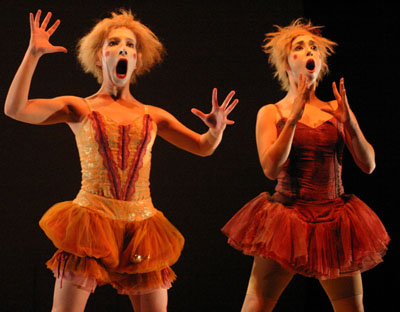|
Every once in awhile a performance happens and suddenly everyone is talking about it. That's how it was when Inbal Pinto Dance Company of Israel performed in San Francisco May 5-7. There was a lot of competition that weekend but this little known yet highly regarded company nonetheless packed the house at Yerba Buena Center for the Arts and enraptured audiences. The competition included a San Francisco Ballet gala retirement party for Yuri Possokhov, Peter Brandenhoff and Stephen LeGate and, not only that, it was Cinqo de Mayo. After the rousing immigration demonstrations of May 1, San Francisco's streets were still warm and people were ready to party. Inbal Pinto Dance Company's sixty-minute piece Oyster was more than strong enough to stand up to even these formidable challenger
Oyster is a series of vignettes, at once delightful, disturbing, poignant and baffling. A collage of striking imagery based on vocabularies borrowed from gymnastics, the ballet, the circus, and excavated from the daring minds of the co-choreographers, the piece is an invitation to fall free and enjoy the hyper-stimulating visual and aural sensations.
Inbal Pinto and Avshalom Pollak shared the work of choreographing, directing, costuming, designing the sets, soundtracks and the fabulous and various wigs worn by the performers. Though still is their twenties, they have collaborated on a substantial body of work and enjoy international acclaim, such as it is for choreographers of unusual work. Most of the dancers are also quite young and their biographies boast extensive training and performance careers since their original appearances as infants in Israel around 1980.
All of the performers threw themselves into their tasks with abandon and a sense of humor that belied their formidable technical abilities. They seemed to say "technique, schmecknique – watch this!" as they did back flips, dropped repeatedly to their widespread knees and moved gently and poignantly to the varied sound score. The movement vocabulary is unique and unusual but the company handles it with such ease, it seems to have been codified for generations.
Among the various and fascinating vignettes presented during the hour-long piece, Shi Pratt, Dana Shoval Ella Rothschild, Noga Harmelin and Naomi Nissim danced a lovely meditation with long red ribbons connecting their hands to their feet. While never allowing the ribbons to slacken, they moved like self-controlled marionettes within the strictly defined boundaries allowed by the ribbons. It was not only lovely to watch and a staggering demonstration of disciplined rehearsal, it was performed with such attention to detail that the audience seemed to hold its collective breath.
A wildly imaginative tango was both hilariously funny and frightening. The two dancers, Idan Yoaav and Noga Harmelin, extended the typical tango movements into violent acrobatic caricatures of domination, separation and passionate bonding. At unpredictable intervals the couple flew offstage and into the wings by the tempestuous momentum created by their dramatic centrifugal force. Moments later they reappeared, or one or the other of them did, and the elastic separating and rebounding continued. Traditional Argentine tango can seem repetitive and the drama forced but in this version the emotional variation and intensity provided lots of surprises while maintaining the integrity of the dance.
 |
The closing duet performed by Shi Pratt and Noga Harmenlin with music entitled Anti Anni Prima, from the film Enrico IV, by Astor Piazzola, was filled with melancholy. The tender performances by the dancers created an intimacy with the audience that left us craving more yet understanding that the work was complete. Sadly this is rare in dance works. Often the choreography is overlong and ideas are so overworked that one experiences only relief when it is over. When Oyster came to its graceful close, I wanted the performers to start over and do it all again.
The extraordinary creativity of the collaborators was matched by crisp production values and extensive rehearsal. Lighting, costumes, sets and stage management were all executed with precision and professionalism. Perhaps it's the lack of funding available these days to American companies, but this kind of professionalism is rare.
This refreshing work of magic and genius was the highlight of a strong season of dance in San Francisco. In fact, many seasons.
|